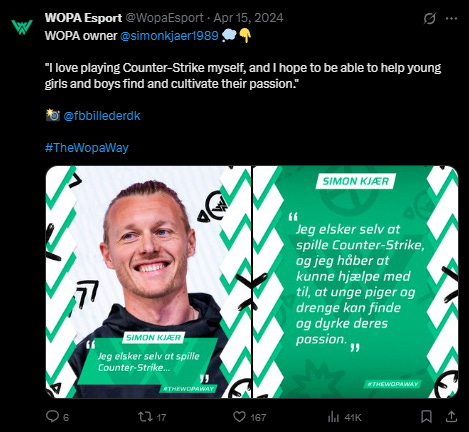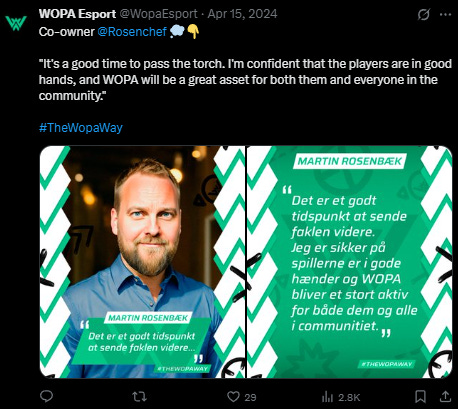Sources: HLTV & WOPA - A New Chapter in Esports’ Ongoing Conflict‑of‑Interest Saga
HLTV’s founder‑CEO co‑owns WOPA with Simon Kjær; messages between HLTV and the Danish organization show that it was told the qualifier wasn’t VRS‑eligible before the tournament organizer discovered it
In a startling turn, internal communications reveal that HLTV tipped off WOPA on October 6th that the “GAME ZONE MASTERS ROAD TO PGA 2025 – Open Qualifier 1” did not meet Valve’s Tournament Operation Regulations (TOR) and therefore was not VRS‑eligible. Despite the organizer’s belief—and its marking of the event as a TOR qualifier—later investigations confirmed the tournament fell short of the required standards. Crucially, WOPA possessed this knowledge well before the broader community became aware, setting the stage for a deeper look into how the misinformation spread.
Background on WOPA
On April 15th 2024 the Danish esports organization WOPA was announced, led by Danish footballer Simon Kjær and co‑owner Martin “Rosenchef” Rosenbæk, the founder and CEO of the Counter‑Strike news site HLTV.org.
WOPA’s launch message stressed a vision of “healthy habits, a healthy approach, and healthy gaming.” The group pledged a non‑toxic community open to everyone, a professional mindset, focused development, and a commitment to nurturing Danish talent.
According to proff.dk, Rosenbæk’s wife is the CEO of WOPA. Martin remains actively involved in the project.
Investigating the VRS‑Eligibility of “GAME ZONE MASTERS ROAD TO PGA 2025 – Open Qualifier 1”
To determine whether the tournament met Valve’s VRS standards, this publication consulted Graham “messioso” Pitt, to use his expertise on TOR. His analysis concluded that the event failed to satisfy multiple key eligibility criteria. Below is one illustrative example where the tournament organizer fell short of the TOR requirements.

Since GAME ZONE MASTERS were classified as a Tier 2 tournament and does not feature VRS invitations, it falls under point C of the regulations. Accordingly, the tournament organizer (TO) was required to publish the qualifier announcement at least fourteen days before the qualifier’s start date. A quick scan of the TO’s X timeline shows that this deadline was not met.
First-hand account
This publication reached out to Łukasz “PRAWUS” Ganczewski, tournament director for Good Game, who hosted the qualifier, and asked him to describe what transpired:
“(…) In our case, everything started quite normally. At the end of September, we submitted the license application to Valve for our tournament Game Zone Masters: Road to PGA 2025. Under the rules valid at that time, announcing a tournament simply required publishing all relevant documentation publicly — in our case, on GitHub — which we did. Around mid-September we had also verified the structure with Valve, and there were no objections or any indication that the requirements would change. Then, near the end of September, Valve updated the Tournament Operation Requirements (TOR), introducing new timing rules: tournaments must be announced at least 14 days before qualifiers and registration must open at least 7 days before. We submitted the event to HLTV on October 3. On October 7, before the first qualifiers began, we reached out to Florin Botezatu from HLTV to confirm everything was fine — first in the morning, then again during the day and in the evening.
By that time, one round of qualifiers had already been played. We immediately paused the tournament and, on October 8, prepared a fully revised version that met all new TOR requirements — with announcement on October 8, registration on October 15, qualifiers on October 22–23, and LAN finals on October 25–26. We sent this to HLTV the same day and also reached out to Valve, following their instructions.
Despite multiple attempts, we received no response until October 9 at 23:12, when we were informed that the current format didn’t comply with the updated TOR and that we should contact Valve directly. Unfortunately, Valve never replied, despite multiple follow-ups over the following days. With the LAN finals approaching and no confirmation from either HLTV or Valve, we had to proceed with the tournament as unranked, keeping the same prize pool, schedule, and quality standards.”
The new TOR timing rules and the organizer’s misunderstanding of the public‑announcement requirement meant the TO failed to satisfy the regulations. Equally noteworthy is HLTV’s silence; while the TO could have consulted the published TOR documents independently, the absence of a timely response from HLTV raises the question of whether the platform bears any responsibility for informing organizers about VRS eligibility.
Observations from messioso
“(…) (Linking to the GitHub page of the qualifier) these were created October 1st. The first qualifier started October 7th. There must be 2 weeks announcement period at least. They fail c) here (sending a screenshot of 4.3 Additional information in the TOR regulations)”
Reflections from PRAWUS
“I fully understand that if I had closely followed Valve’s updates, this situation probably wouldn’t have happened. It’s just unfortunate that HLTV’s response came so late, if we had received it a bit earlier, we might have still had time to react and adjust before the qualifiers started.”
The conflict of interest between HLTV and WOPA
The chronology of communications makes the conflict of interest starkly visible.
End of September: GAME ZONE MASTERS ROAD TO PGA 2025 submitted the license application to Valve, which was valid at the time to get TOR status. According to PRAWUS it was enough to publish all relevant documentation on GitHub. Furthermore, PRAWUS added:
“(…) Valve updated the Tournament Operation Requirements (TOR), introducing new timing rules: tournaments must be announced at least 14 days before qualifiers and registration must open at least 7 days before.”
October 1st: The Tournament is announced on GitHub.
October 3rd: The Tournament was submitted to HLTV.
October 6th – Person(s) from HLTV told WOPA:
“I’ve tried to tell WOPA that it’s not a VRS tournament they’re signing up for. Because it doesn’t meet the rules. So I would simply advise them not to play it (…)”
This warning reached WOPA before the TO (PRAWUS) was aware that the event violated TOR.
October 7th – The TO contacted HLTV (Florin Botezatu, Global coverage, match highlights, VODs and Demos at HLTV) three times in one day to confirm the qualifier’s status. One round of the qualifier had been played at this point.
October 8th – After pausing the event, the TO submitted a revised schedule to both HLTV and Valve that they believed complied with the new TOR.
October 9th – HLTV responded, confirming the format was non‑compliant and advising the TO to contact Valve directly.
Because Martin “Rosenchef” Rosenbæk is simultaneously the CEO/founder of HLTV and a co‑founder of WOPA, the early warning given to WOPA creates a clear conflict of interest: HLTV possessed privileged information about a tournament’s VRS eligibility and shared it with a party that could benefit competitively, while withholding the same information from the tournament organizer.
Implications of the future
The fact that HLTV’s founder‑CEO also sits on the ownership table of WOPA—a Danish esports organisation co‑founded with the Danish football player Simon Kjær—creates an inherent tension that goes beyond ordinary business partnerships. This publication received documented evidence that person(s) from HLTV warned WOPA that the upcoming “GAME ZONE MASTERS ROAD TO PGA 2025 – Open Qualifier 1” would not qualify for Valve’s Regional Standings (VRS) before the tournament organizer realised the breach.
If a party that controls a major source of tournament coverage can tip off a co‑owned team about eligibility, does that give the team an unfair strategic advantage over rivals who are left in the dark? It does.
Traveling to tournaments is a costly affair for teams, who are at the same level as WOPA. If WOPA doesn’t attend an event like EPIC LAN (Oct 30th-Nov 2nd), would that send bad signals for teams who intend to compete in the tournament, since they might have information that hasn’t been shared? Will it affect the general coverage of the tournament?
There is an argument to be had, that the teams themselves have access to Valve’s TOR, and put the onus on themselves to stay informed about the eligibility of the tournaments they are attending.
In short, the overlap between HLTV’s editorial influence and its co‑ownership of WOPA blurs the line between reporting and advocacy. The episode underscores the need for clear, publicly documented procedures that separate media coverage from competitive decision‑making, ensuring that every team competes on an even informational footing.
As Uncle Ben said in Spiderman: “With great power comes great responsibility” and in this case there is a conflict of interest in the middle of the great power and responsibility HLTV have.




